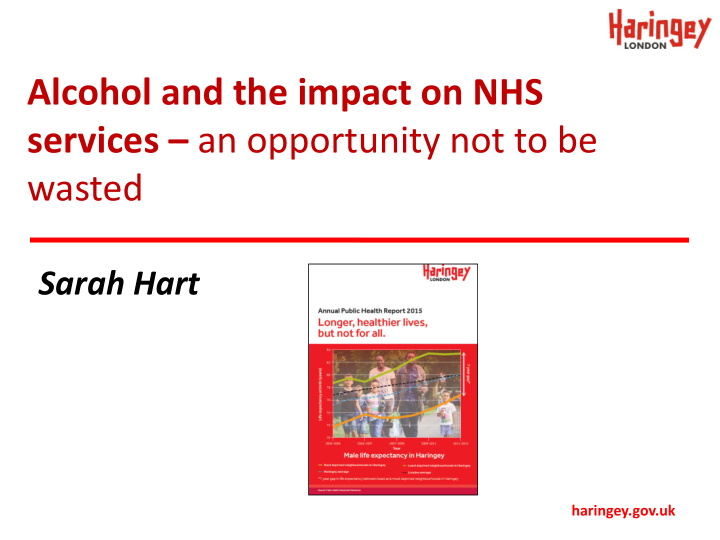



Alcohol and the impact on NHS services – an opportunity not to be wasted Sarah Hart haringey.gov.uk
Top 5 Risk Factors haringey.gov.uk
Why is alcohol an important issue to the CCG ? Source: Public Health England (2016) haringey.gov.uk Health matters: harmful drinking and alcohol dependence’
Two methods of assessing alcohol related admissions and mortality Alcohol-specific conditions (narrow measure) Alcohol-specific conditions include those conditions where alcohol is causally implicated in all cases of the condition; for example, alcohol-induced behavioural disorders and alcohol-related liver cirrhosis. The alcohol-attributable fraction is 1.0 because all cases (100%) are caused by alcohol. Alcohol-related conditions (broad measure) Alcohol-related conditions include all alcohol-specific conditions, plus those where alcohol is causally implicated in some but not all cases of the outcome, for example hypertensive diseases, various cancers and falls. The attributable fractions for alcohol-related outcomes used here range from between 0 and less than 1.0. Source: (Public Health Outcomes Framework, 2016) haringey.gov.uk
Recent alcohol mortality rate data shows decreases in Haringey in context of regional / national plateaus 8.3% decrease in DSR alcohol related deaths (2010-12 to 2011-13). Haringey now below England but still above London (27 th lowest in London in 2013). 30% decrease in DSR alcohol specific deaths 2010-12 to 2011-13, now level with London and below England. 16 th highest in London in 2011-13. haringey.gov.uk
However, hospital admission rates are increasing in Haringey, London and England Total alcohol- related hospital admissions have increased by 29% from 2009 – 2014. 8% more than London with a 21% increase. London benchmarking for 2014/2015 shows alcohol- related admission rates are higher than our neighbours, London and England. Haringey the 6 th highest in London. haringey.gov.uk
Alcohol specific admissions have plateaued in Haringey reflecting the national, regional trend, but remain high Total alcohol-specific hospital admissions have remained steady from 2009 to 2015 but remain higher than London average. In the last 4 years London has decreased by 7%, whilst Haringey has decreased by 4% in comparison. London benchmarking for 2014/2015 shows alcohol- specific admissions are higher than our neighbours . 4 th highest in London. haringey.gov.uk
Increasing alcohol- related burden on England’s hospitals • 2008/9 – 2013/14 A&E attendances rates – attendance rates of alcohol poisoning doubled, from 72.7 to 148.8 per 100,000 2X population • 35% of all Accident & Emergency (A&E) attendance and ambulance costs may be alcohol related, increasing to 70% of A&E attendances at peak times on the weekends • Inpatient admissions specific to alcohol 2005/06 to 2013/14, increased by 63% rise 63% : there was a 143.3% increase in elective admissions (from 45.5 per 100,000 population to 110.8 per 100,000 population) 53.9% increase in emergency admissions (from 374.9 per 100,000 population to 577.1 per 100,000 population). • In 2013/14, approximately 1 in 20 emergency admissions and 1 in 120 elective admissions were for alcohol-specific conditions • 22 - 35% of GP visits estimated to be related to alcohol 22-35% Sources: Nuffield Trust (2015), Department of Health (2008), haringey.gov.uk
Haringey drinking consumption patterns 9 10, 000 High risk 35+ units a week drinkers (4%) 50+ units a week Increasing risk 15-35 units a week 57,000 drinkers (20%) 22-50 units a week Increasing risk Low risk ≤ 15 units a week 115,000 drinkers ≤ 22 units a week Harngey London England Low risk drinkers Source: Adapted from Alcohol treatment performance Source: Local Alcohol Profiles for England - from report, NCL 2012. PHOF 2014 August) haringey.gov.uk
Tackling the burden of alcohol misuse? Population level interventions Interventions through Interventions communities through services Alcohol screening in A&E Alcohol nurses in primary care Alcohol workers in hospitals Alcohol community detoxification haringey.gov.uk
Need for population measures Population-based approaches to reducing alcohol-related harms – •Increased taxation •minimum unit pricing •restricting availability •limiting marketing and advertising. haringey.gov.uk
Systemic approach of interventions at community and service level in Haringey • Alcohol CQUIN in A&E Tier 1: • Health checks Building capacity in the • Training professionals i.e. GPs, A&E Low to • key professionals to Don’t bottle it up website and drink coach increasing risk • Stalls/social marketing deliver a brief screen • MECC and health champions and brief advice • IBA in police custody suites • Hospital Link worker delivering outpatient interventions and on ward Tier 2: • GP hubs Nurse Extended Brief • Drug and alcohol services Increasing Interventions and high risk • Hospital link worker supporting ward detox’s Tier 3: • Community detoxification programmes Intensive support/ • Access to inpatient detoxification Specialist advice • Harm reduction programme - those not ready to stop High risk • and Abstinence day programme Dependent • Counselling • Primary care alcohol and Mental health counsellor haringey.gov.uk
North Middlesex Hospital Alcohol services - Teachable moment, 1:8 Working with 30 repeat attendees, at NMH 53 low risk will change people had 900 behaviour. A&E CQUIN attendances/admissions - Strong evidence you can in a year , 75% case load catch alcohol related have a housing issue, medical conditions early 65% mental health Alcohol Link worker Liaison - Repeat -S upports CQUIN service attenders - Alcohol interventions on medical wards 114 detoxification supported on wards Source: through to community haringey.gov.uk in 2014
Recommend
More recommend